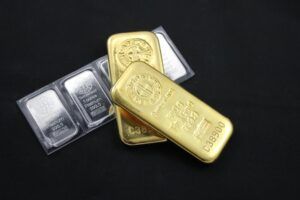Gold Briefly Dips As Risk Aversion Fades on Israel-Iran Ceasefire, China Trade Deal
Posted on — Leave a commentGold briefly slipped to a four-week low as some investors rotated back toward riskier assets, such as stocks, following the Israel-Iran ceasefire deal, which appears to be holding for now. Stocks climbed after President Trump said a trade deal had been signed with China, as Beijing agreed to approve rare earth exports.
Investors and traders had piled into the safety of precious metals as missiles flew in the Middle East and amid concerns that trade was slowing between the world’s two largest economies. The ceasefire and trade deal alleviated some of the market’s most pressing geopolitical and economic concerns, prompting light profit-taking in gold.
Gold slid below $3,300 an ounce as short-term traders took profits on the recent double-digit rally in precious metals. The long-term trend remains positive for gold, and the metal remains well above its 200-day moving average, a technical signal that confirms the uptrend remains in place.
Gold and Silver Remain the Best Performing Asset Class in 2025
Even with the light pullback in gold prices, the precious metal is still notching a 21% gain since the start of the year, with silver up 20%, both handily beating the 4.41% gain in the S&P 500 this year.
Key Inflation Gauge Ticks Modestly Higher
The Federal Reserve’s preferred inflation indicator, the personal consumption expenditure (PCE), rose by 2.3% over the 12 months through May, the Commerce Department said. Excluding food and energy, core PCE inflation rose to 2.7% in May, from 2.6% in April. While the uptick in inflation is positive for the precious metals sector, gold and silver showed little reaction as the easing of the Middle East conflict, for now, has dampened fresh demand for precious metals.
Consumer Spending Drops for the First Time in 2025
Americans spent less in May on both goods and services as consumer spending fell 0.1%. Economists had expected consumer spending to gain 0.1% last month. Consumers bought fewer cars and spent less at restaurants and hotels.
Economists say that consumer worries about tariff hikes translated into weaker spending in the second quarter, which could have a broader impact throughout the year. Consumer spending is a major driver of the American economy, accounting for over two-thirds of all economic activity.
The Bottom Line
The price pullback in gold offers long-term investors an opportunity to accumulate precious metal at lower prices. Now is an opportune time to trade fewer of your dollars for more gold. A number of major Wall Street firms target gains to the $4,000 area and beyond in the months and years ahead. Today’s pricing on gold offers long-term investors an opportunity to increase their allocation to the safety and security of precious metals while they are effectively on sale. Use the summer complacency as your opportunity to make savvy market moves.








